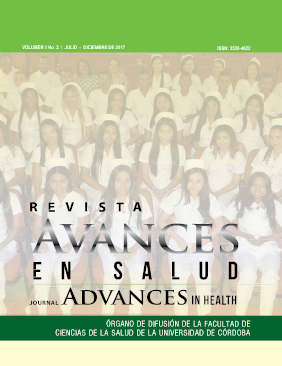Frequency of the antigens of the system rh in blood donors Rh D Negative
Frecuencia de los antígenos del sistema Rh en donantes de sangre Rh D Negativo.
Show authors biography
Objective. To determine the frequency of antigens of the Rh system in donors of Rh D negative blood. Materials and methods. Retrospective and descriptive study where all the records of Rh D negative blood donors from the Blood Bank of Cordoba between the years 2012-2015 were reviewed. To describe the sociodemographic characteristics of Rh D negative blood donors and to identify the frequency of phenotypes of the Rh system, absolute, relative and confidence intervals were calculated for 95% ratios to compare Rh system phenotypes according to the ABO group And sociodemographic variables, absolute, relative frequencies, 95% confidence intervals and Chi square test were calculated. p values <0.05 were considered significant and the information was stored and analyzed in SPSS version 23. Results. The phenotype found most frequently was ccee, which corresponded to 92%; the other phenotypes were found in lower percentages distributed as follows: Ccee 5.9%, ccEe 1.2%, CCee 0.3%, and CCEE 0.2%. 88% of the donations were made by male donors and the ABO blood group with the highest frequency was found to be O corresponding to 66.4%. Conclusion. Both nationally and globally, the most frequent phenotype for Rh D negative people is ccee, with a slight variation in their percentage of repetition between regions.
Article visits 2927 | PDF visits
Downloads
- Majluf CA & Pérez Ó. Hematología Básica. México: GARMARTE, S.A. DE C.V, 2006.
- Vásquez Rojas M. Castillo Espinosa, D. Pavez Espinoza, Y. Frecuencia de antígenos del sistema sanguíneo Rh y del sistema Kell en donantes de sangre. Revista Cubana de Hematol, Inmunol y Hemoter. 2015;31(2):160-171.
- Daniels G, Castilho L, Flegel WA, Fletcher A, Garratty G, Levene C, Et at. International Society of Blood Transfusion Committee on terminology for red blood cell suface antigens: Macao report. Vox sang 2009, 96:153-156.
- Rivas, J y Sucre, W. Determinación de Transfusiones Sanguíneas con Fenotipos del Sistema Rh Incompatibles, Analizados Mediante Pruebas Inmunohematológicas en Receptores y Unidades De Sangre Transfundidas, remitidas por El Banco De Sangre Fausto Castello De La Cruz Roja Provincial De Napo.Quito; 2014.
- McClelland DBL, P. E. Manual uso óptimo de componentes sanguíneos. España; 2011.
- Alvarado V, Dubon M. Tipificación de Antígenos Eritrocitarios del Sistema Rh y Kell en Donadores de Sangre que asistieron a dos Hospitales de la Ciudad de Guatemala. Universidad de San Carlos de Guatemala. 2012.
- Elsayid M, Al Qahtani FS, Al Qarni AM, Almajed F, Al Saqri F, Qureshi S., et al.: Determination of the frequency of the most immunogenic Rhesus antigens among Saudi donors in King Abdulaziz Medical City – Riyadh. J Nat Sci Biol Med. 2017 Jan- Jun; 8(1):56-59.
- Navarrete, R y Segura, D. Frecuencia de fenotipos del sistema rh-hr en donantes rh negativos en el Hospital SanVicente de Paul. Rev. Med. de costa rica y Centroamérica LXIX. 2012; 143-147.
- Mantilla Gutierrez C, Cardona Arias J, Pérez Escobar R. Caracterización clínica y hematológica de donantes a repetición de un Banco de Sangre de Medellín-Colombia, 2011. Medicina y Laboratorio. Volumen 18 (9-10): 459 - 470.
- García M, Sáenz E & Cruz J. Estudio de factores socioculturales relacionados con la donación voluntaria de sangre en Las Américas. Revista Panamericana de Salud Pública. 2003; vol 13: 85- 90.
- Cruz Bermúdez HF. Moreno Collazo JE. Forero SE. Caracterización de donantes voluntarios de sangre por grupo sanguíneo ABO y Rh que asistieron a un banco de sangre de la ciudad de Tunja- Colombia; Volumen 12 (N°2): 185 - 189.
- Organización Mundial de la Salud. Disponibilidad y seguridad de la sangre a nivel mundial. Nota descriptiva; junio 2017. Manual de Normas Técnicas, Administrativas y de procedimiento de Banco de Sangre. Resolución 901/1996 de 20 de marzo.







